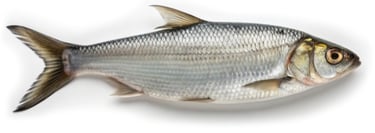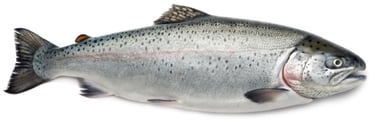
Fish_
Discover the vibrant world of fish in the Columbia River Gorge. From salmon to sturgeon, explore the diverse species thriving in its waters, enticing anglers from all over to experience the thrill of fishing in this majestic landscape
American Shad _Alosa sapidissima
American shad are members of the herring family. Adults average 15 to 17 inches in length and weigh two to six pounds. They can grow as large as 13 pounds. These Atlantic Ocean fish were introduced into the Sacramento River in 1871 and are now found as far north as Alaska along the Pacific coast. Adult shad spend three to five years in the ocean. Most return to spawn in open water in the Columbia River at age five. Not all shad die after spawning and some may actually return to spawn up to five times during their lifetime. Juveniles spend the summer in fresh water and migrate to the ocean in the fall.
When They Pass The Dams
Shad can be seen in the fish ladders o lower Columbia River dams from May to August. The run peaks in mid-June.
Distinguishing Characteristics
Teardrop body shape
Deeply notched tail that forms a "V"
Several large spots along the back between the head and dorsal fin
Often seen in groups
Iridescent in bright light with large scales (like carp)
No adipose fin




Chinook Salmon _Oncorhynchus tshawytscha
Chinook (or King) salmon are the largest of the Columbia River salmon. Adults average 22 pounds but many people frequently see 40 to 50 pound fish in the fish ladders at Bonneville Dam.
Chinook salmon spawn in the late summer and fall and die. In the spring, their offspring use the runoff provided by snowmelt to migrate to the ocean. Fingerlings from the spring and summer runs may stay in the river up to one and one-half years before starting their downstream migration. After spending two to five years in the ocean, the chinook migrate up the Columbia River to the stream where they were born. There, they spawn and die, completing the cycle.
When They Pass The Dams
Chinook salmon pass the lower Columbia River dams between April and November in three runs:
Spring: March to June
Summer: June to July
Fall: August to November (most numerous)
The spring chinook run goes farthest upriver to spawn, the summer run doesn't go as far, and most of the fall run stays in the lower Columbia tributaries though some stocks go into the Snake River and its tributaries and some fall chinook do spawn above the lower Columbia River.
Distinguishing Characteristics
Large Size
Oval Body
Silver in color until close to spawning when the males turn a dark "dirty" maroon hue or red color. The females become darker silver to almost black
Spots on the upper portion of body and on the tail or 'caudal fin'
Crescent shape end tail
Black gum line
Coho Salmon _Oncorhynchus kisutch
Mature Columbia River coho (or silver) salmon average six to 12 pounds and can grow as large as 26 pounds.
Coho juveniles spend about a year in the stream where they were spawned and move out of those streams when they are three and one-half or four and one-half inches long. They migrate to the ocean during the spring runoff. Adults generally spend one to two years in the ocean before returning to spawn and die in the stream where they were born.
When They Pass The Dams
The coho go through the fish ladders of lower Columbia River dams between August and November, with the peak of the run during September.
Distinguishing Characteristics
Coho is most often confused with the chinook
Long oval body
Silver in color until they are near spawning, when the male turns a brick-red color and the female becomes a dull bronze
Spots on upper portion of body and on upper tip of tail
Crescent shaped end of tail
White gum line
"Nose" protrudes over lower jaw as the fish near spawning


Lamprey _Entosphenus tridentatus
The Pacific Lamprey has been an important fish in the Columbia River for centuries and is vital to Columbia River tribal fisheries. Lamprey have few natural predators.
Lamprey look so much like an eel that people often call them "lamprey eels." These three-toothed lamprey are anadromous, meaning they are born in freshwater, grow to maturity in the ocean and return to the fresh water to reproduce. They swim using a snake-like motion and rest by attaching to rocks with their suction-cup-shaped mouths.
When They Pass The Dams
Lamprey can be seen in the fish ladders of lower Columbia River dams from June to August.
Distinguishing Characteristics
Body shaped like an eel
Three-toothed suction-cup mouth
Skeleton make of cartilage
Life span of 7 years or more
Female lays between 34,000 and 106,000 eggs
Returning adult average size 22 to 28 inches


Sockeye Salmon _Oncorhynchus nerka
Mature sockeye salmon (commonly called blueback, silver-side, Alaska red, or nerka) average three to seven pounds but can get as large as 15 pounds.
Unlike other salmon, sockeye require spawning grounds in streams flowing into or from lakes. After sockeye eggs hatch in the stream, juveniles migrate to a lake and spend one to two years there before migrating to the ocean. They will mature in the ocean and usually return to the same stream to spawn between the ages of two and five.
When They Pass The Dams
The peak of this run can be found in the lower Columbia River in July, although sockeye can be seen as early as May and as late as August.
Distinguishing Characteristics
Metallic blue back with silvery sides
Spawning makes turn bright red with a green head and tail and a hump on their backs. Females turn a similar color, but the body is a darker blotched red and has no hump
Fine black speckles are visible especially during spawning but are difficult to see in migrating adults when they are still bright (or silvery) when they return from the ocean
Almost clear tail and fins


Steelhead _Oncorhynchus mykiss
Steelhead are rainbow trout that migrate to the sea. They average 10 pounds and can grow as large as 42 pounds.
Unlike salmon, steelhead do not necessarily die after spawning and a few may spawn several times. They spend from one to four years in the ocean before returning to their spawning streams (any time from late winter to late spring). Juvenile steelhead can spend from one to three years in fresh water before migrating to the ocean.
When They Pass The Dams
Steelhead can been seen throughout the year although most steelhead move past the lower Columbia River dams from July through September. There are two runs of steelhead:
Summer: April through October
Winter: November through April
Many winter run steelhead spawn in the lower Columbia tributaries. Summer run fish pass the lower Columbia River dams and migrate to the upper reaches of the Columbia and Snake rivers where they spend the winter and then move to their home streams in the spring to spawn.
Distinguishing Characteristics
Long slender body ("torpedo" shaped)
Steel blue spotted back with silvery sides. When close to spawning, both the make and female develop a pink to rose-red stripe down the sides (the "rainbow") and get a slight olive green tint on the back
White gum line
Squared-off end of tail with fine spots throughout
Hatchery raised fish will have adipose fin (on back just in front of tail) clipped for identification


White Sturgeon _Acipenser transmontanus
White sturgeon are commonly found above and below Bonneville Dam as well as throughout the Columbia and Snake rivers. These fish like deep, cavernous areas and are bottom feeders. Sturgeon are anadromous, which means they go from the ocean to fresh water to spawn. If they are not able to get to the ocean they may successfully live their entire lives in fresh water.
Although rarely seen in the fish ladders at Bonneville, many sturgeon are caught by anglers below the dam. Their roe (eggs) are a delicacy and their flesh in tender and boneless.
When They Pass The Dams
Few sturgeon migrate through the fish ladders. Anglers fish year round for sturgeon below Bonneville Dam. There are a few live sturgeon (adult and juvenile) on display at the Bonneville Fish Hatchery.
Distinguishing Characteristics
Grey color with sharp bony plates (scutes) along the back
The skeleton is mostly cartilage
Toothless mouth protrudes from the underside of the head
Can live up to 100 years
Can grow to 20 feet longs and weigh up to 1,800 pounds
Contrary to popular belief, they do not change sex

